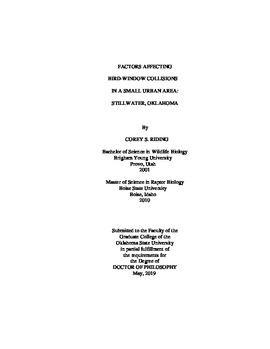| dc.contributor.advisor | Loss, Scott R. | |
| dc.contributor.author | Riding, Corey S. | |
| dc.date.accessioned | 2019-10-25T19:51:44Z | |
| dc.date.available | 2019-10-25T19:51:44Z | |
| dc.date.issued | 2019-05-01 | |
| dc.identifier.uri | https://hdl.handle.net/11244/321573 | |
| dc.description.abstract | This dissertation consists of four concurrent studies of bird-building collisions, which primarily occur at glass surfaces (e.g., windows) and are a major source of direct anthropogenic mortality for birds globally. Although research, public, and policy interest concerning bird-window collisions are increasing, this issue has primarily been studied in larger metropolitan areas, particularly in the eastern third of North America. It is unknown if bird-window collisions in smaller urban areas in other regions (e.g., the U.S. Great Plains) are influenced similarly by the same factors. Chapter 1 examined some biases that cause researchers to underestimate the number of fatal bird-window collisions. Because of high carcass persistence and observer detection rates, we estimated that across seasons we detected about 88% of fatal collision victims. Also, we provided formal definitions to distinguish scavenging and removal events to promote consistent terminology use. Chapter 2 investigated the temporal patterns of fatal and non-fatal window collisions. We found that more collisions occurred at night or early morning than late morning or afternoon. In addition, weekly and monthly variation indicated more collisions during migratory periods, especially spring, and greater mortality of non-migrating individuals than expected. Chapter 3 assessed the fine-scale spatial patterns of window collision mortality. The inter-seasonal and inter-species variation that we found across building facades suggested that targeted mitigation efforts may be applied at small spatial scales but need to identify conservation goals for maximum effect. Chapter 4 considered the effects of artificial lighting at night on building collision frequency. We did not find a strong spatial relationship between the lightscape (variation in nocturnal light intensity) and the collision mortality intensity, but there were several factors that may have confounded our results. Overall, our findings both corroborated and disputed results from previous studies, indicating that although the general phenomenon of bird-window collisions is similar across various contexts, the details of urban development, geographic region, and building facade structure may strongly influence local outcomes. These findings should help inform conservation efforts to reduce bird-window mortality and suggest that further research should be conducted in under-studied localities. | |
| dc.format | application/pdf | |
| dc.language | en_US | |
| dc.rights | Copyright is held by the author who has granted the Oklahoma State University Library the non-exclusive right to share this material in its institutional repository. Contact Digital Library Services at lib-dls@okstate.edu or 405-744-9161 for the permission policy on the use, reproduction or distribution of this material. | |
| dc.title | Factors Affecting Bird-Window Collisions in a Small Urban Area: Stillwater, Oklahoma | |
| dc.contributor.committeeMember | O'Connell, Timothy J. | |
| dc.contributor.committeeMember | Baum, Kristen A. | |
| dc.contributor.committeeMember | Grindstaff, Jennifer | |
| osu.filename | Riding_okstate_0664D_16148.pdf | |
| osu.accesstype | Open Access | |
| dc.type.genre | Dissertation | |
| dc.type.material | Text | |
| dc.subject.keywords | avian mortality | |
| dc.subject.keywords | bird-window collisions | |
| dc.subject.keywords | carcass surveys | |
| dc.subject.keywords | light pollution | |
| dc.subject.keywords | urban ecology | |
| dc.subject.keywords | wildlife collisions | |
| thesis.degree.discipline | Natural Resource Ecology and Management | |
| thesis.degree.grantor | Oklahoma State University | |
